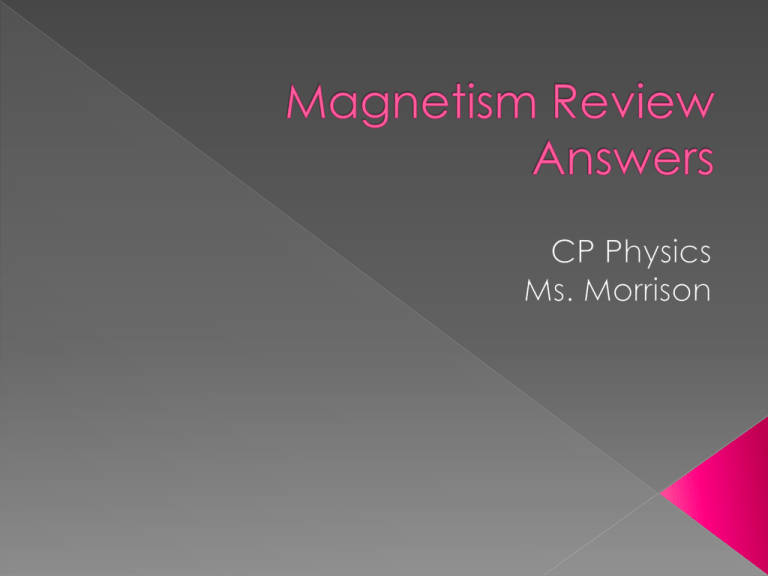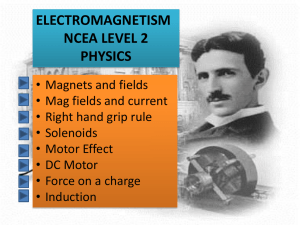Magnetism Review Answers
advertisement

Magnetic field lines: lines of force representing the magnetic field around a magnet Magnetic pole: the end of the magnet which produces magnetic force Magnetic field: the space around a magnet through which magnetic force acts ALNICO magnet: a magnet made up of the elements of aluminum, nickel, and cobalt; these three metals when combined are ferromagnetic Magnetic domain: a cluster of atoms which have aligned magnetic fields Electromagnet: a current-carrying coil of wire Magnetic declination: the difference between the location of the true North pole and the magnetic North pole Aurora borealis: also known as the Northern Lights, colored lights seen in higher latitudes due to charged particles interacting with Earth’s magnetic field in the upper atmosphere Transformer: an iron core with two coils of wire (primary and secondary), it changes voltage; step-up = increases voltage, step-down = decreases voltage Electromagnetic induction: generating electricity by moving a coil of wire in a magnet’s magnetic field Like charges and poles repel Opposite charges and poles attract Both charges and poles exert forces which can act over a distance – they do not have to have direct contact for the force to be experienced Electric charges can be separated from each other – can remove negative charges from an object Magnetic poles cannot be separated from each other – trying to break a magnet in half to separate the North from the South does not result in separate poles – just two smaller magnets The magnetic field lines leave the north pole, curve around, and enter the south pole. You can see the magnetic field lines by sprinkling iron filings over the magnet. The filings will line up to show the field lines around the magnet. The magnetic field is strongest at the poles. Magnetic fields are created by moving charges, like electrons spinning or electrons flowing through a wire. An electron Most materials have atoms which have paired-up electrons so the magnetic fields of all the electrons cancel each other out so there is no remaining magnetic fields. Each iron atom has 4 unpaired electrons. Their magnetic fields add to each other to produce a strong magnetic field in each atom. The domains in the permanent magnet line up one direction, while the domains in the nonmagnetic material are randomly arranged. When the domains line up, the magnetic fields add together creating a stronger permanent magnetic field. Yes, if the material contains some iron or ALNICO. It must be put into a strong magnetic field and it will be become temporarily magnetized. This is because the magnetic field will cause the random domains to line up. Once the magnetic field is removed, the domains will return to their random, unaligned state. Heating them, dropping them, or repeatedly hammering them. This causes the domains in the magnet to become unaligned and randomly arranged. Oersted discovered that electricity moving through a wire caused a magnetic field to be created. He was conducting electric circuit experiments and had a compass near his circuit. When a electric current went through the circuit, the needle of the compass was deflected. The magnetic field will also reverse its direction. A coil of wire is placed inside a permanent magnet. When electricity goes through the wire, the coil of wire becomes an electromagnet and interacts with the magnet’s magnetic field. The wire then spins. Every 180o the current reverses direction so that the wire keeps spinning and spinning. (Electromagnet’s magnetic field also keeps reversing.) Motors convert electrical energy into mechanical energy. The motion of charged particles within the molten part of Earth’s core is thought to generate the Earth’s magnetic field. It reduces the intensity of cosmic rays coming from the sun. It traps the Van Allen Radiation belt which can sometimes interact with the Earth’s magnetic field to produce the Northern lights. The number of loops – more loops in the coil will increase the strength The amount of current – the greater the current through the coil will increase the strength The presence of an iron core – if an iron core is present it makes the electromagnet stronger Michael Faraday Move a wire in and out of a magnetic field Move a magnet in and out of a coil of wire A coil of wire is located inside a permanent magnet – just like a motor. When you turn the coil of wire, electricity is generated because the wire is moving within a magnetic field. So, electricity is produced when the coil of wire is spun within the magnet. Generators convert mechanical energy into electrical energy. (opposite to motors) Alternating current (AC) The number of loops in the wire – more loops will produce more voltage The strength of the magnet – the stronger the magnet the more voltage produced The speed of rotation of the wire – the faster it spins, the more voltage produced See answer to question #19 OMIT The field lines should leave the north pole with arrows pointing out of the north pole, curve around, and then enter the south pole. So, the arrows should point at the south pole. The lines will leave and move up and curve way from the north poles. They do not touch each other. The arrows point outwards. For two south poles, you see a similar pattern with the lines curving up and away from the poles, but the arrows point towards the south poles. The arrows point inwards. The lines will move from the north pole to the south pole. So the arrows point to the south pole and away from the north pole. L = 0.6 m B = 0.400 T I = 4.00 A F=? F = BIL = (0.4)(4)(0.6) F = 0.96 N L = 2.0 m I = 12 A F = 0.50 N B=? F = BIL 0.50 = B(12)(2) 24 24 B = 0.021 T F = 0.96 N I = 5.6 A B = 0.37 T L=? F = BIL 0.96 = (0.37)(5.6)L 2.072 2.072 L = 0.46 m Q = 1.6 x 10-19 C B = 0.75 T v = 4.8 x 107 m/s F=? F = BQv = (0.75)(1.6 x 10-19)(4.8 x 107) F = 5.76 x 10-12 N







